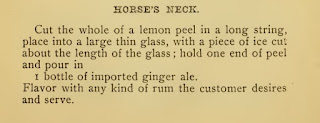Categoria : Long Drink
Mise en place : Bicchiere High-ball, Stir, Lemon (Peel), Brandy, Ginger Ale, Angostura Bitter (optional).
In cl
4 cl di Brandy
12 cl di Ginger Ale
Dash of Angostura bitters (optional)
In once
1 2/4 oz. di Brandy
4 oz. di Ginger Ale
Dash of Angostura bitters (optional)
Vecchia ricetta from "Modern American Drinks” by George J. Kappeler - 1895
Horse’s Neck.
Cut the peel from a lemon in one long piece, place in a thin punch-glass, add a bottle of cold imported ginger ale.
Guarnizione : una spirale di scorza di limone
Tecnica di procedimento : (Build ove ice) si prepara direttamente nel bicchiere Old-Fashioned.
Procedimento : mettere il ghiaccio nel bicchiere e versare gli ingredienti; infine decorare con la scorza di limone.
Nel secondo ricettario Iba del 1987 con la codifica :
Horse's Neck
One entire lemon peel cut in
spiral and hung by the neck into
a tumbler full of ice
one dash of Angostura Bitter (optional)
one measure of Brandy (4 cl)
Top up with Ginger Ale
Nel terzo ricettario Iba del 1993 con la codifica :
Horse's Neck
2/10 Brandy
8/10 Ginger Ale
Alcune gocce di Angostura (a gusto).
Si prepara direttamente in un bicchiere highball con ghiaccio
inserendo una spirale di buccia di limone facendo sormontare
una piccola parte sull'orlo del bicchiere, versarvi gli ingredienti
e se richiesta l'Angostura per ultima.
Nel quarto ricettario Iba del 2004 (categoria After -dinner) con la codifica :
Horse's Neck
4 cl Brandy
11 cl Ginger Ale
Dash Angostura Bitters, optional
Method : Build over ice; brandy, ginger ale, bitter
Glass : Old Fashioned
Garnish : Lemon spiral in glass
Nel quinto ricettario Iba del 2012 (categoria - Contemporary Classics) con la codifica :
HORSE’S NECK
Longdrink
4 cl Brandy
12 cl Ginger Ale
Dash of Angostura bitters (optional)
Pour brandy and ginger ale directly into hi-ball glass with ice cubes. Stir gently.
Garnish with rind of one lemon spiral.
If required, add dashes of Angostura bitters.
Storia
Probabilmente l’unico drink in cui vede la decorazione un elemento fondamentale del cocktail, un ingrediente che dà nome alla bevanda, “Collo di cavallo”.
Non abbiamo delle certezze sulla sua creazione, né un nome né un luogo ma la prima traccia (in questo momento) è il ricettario di George J. Kappeler del 1895 “Modern American Drinks”.
Un “Horse’s Neck” senza la presenza di un elemento alcolico, cosa che vedrà la comparsa di quest’ultimo elemento negli anni successivi.
Un esempio è il ricettario datato 1898 di Joseph L. Haywood “Mixology” in cui vede la presenza facoltativa del Brandy o del Whiskey.
Avrà inoltre negli anni alcuni cambiamenti, aggiunte di bitters come una vasta scelta di distillati proposti nella sua ricetta.
In un singolare articolo datato 1906 del giornale “The Evening Times” troviamo un nota interessante sulla sua creazione; un luogo.
"Horse's Neck," a ginger ale drink flavored with lemon peel, originated in the Bohemian clubs of London. The name is derived from the long, tapering glass in which it is served.
Chi sa se negli anni si avranno nuovi risvolti sulle sue origini.
Timeline
1895 - From "Modern American Drinks” by George J. Kappeler
1895 - From "Fort Wayne Journal"
"Horse's neck" is not an attractive name and from a point of art the beverage is not pretty, but it is extraordinarily palatable. Use tall, thin glasses instead of a pitcher. "Horse's Neck" consists of lemon peel and ginger ale, the theory being that the ginger ale draws out the bitterness in the lemon peel. A lemon is carefully peeled so that it coms [sic] off in one continual spiral, from top to bottom. The glass is then filled with cracked ice, the ginger ale poured in and allowed to stand for several minutes. Straws should invariably be used in serving this drink. Ginger ale alone is extremely palatable, but keep the bottles on ice several hours. The glasses should be half filled with cracked ice.
1898 - From “Mixology” by Joseph L. Haywood
1899 - From “American-Bar” by Aczel Miksa
1900 - From “Harry Johnson's Bartenders' Manual” by Harry Johnson
1900 - From “The 20th century guide for mixing fancy drinks” by Maloney, James C.
1903 - From “Daly's Bartenders' Encyclopedia” by Tim Daly
1904 - From “A Book of Beverages” by Bigelow, Colonel Timothy
1904 - From “Stuart's Fancy Drinks and How to mix them” by Thos. Stuart
1906 - From "The Evening Times", May 15
1912 - From “Wehman Bros Bartenders Guide How to Mix Drinks”
1931 - From “The Old Waldorf-Astoria Bar Days” by Albert S Crockett
1948 - From “The Fine Art Of Mixing Drinks” by David Augustus Embury















